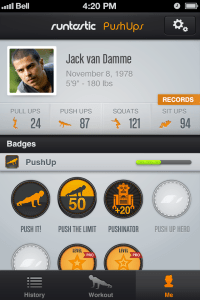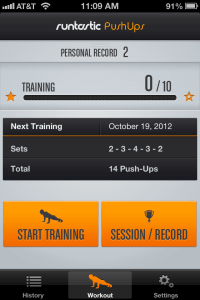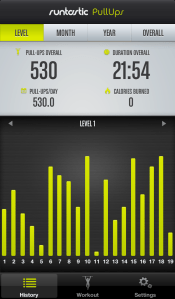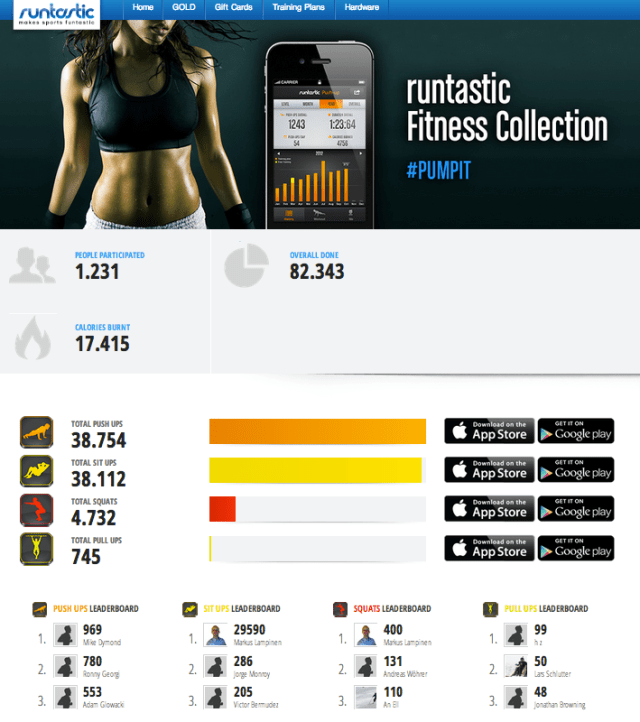Thanks to MapMyFitness, RunKeeper, Nike and many more, apps that keep track of your exercise and push you to drop those extra pounds are by no means novel. Nonetheless, bootstrapped European startup Runtastic is still managing to carve out a name for itself in a crowded space by offering a simple user experience, while still offering the deeper functionality of higher-end products.
Continuing to build out what it intends to be a full-service health and fitness platform, Runtastic today expanded beyond what has been its core focus to date — outdoor recreation, like running and cycling — launching a new suite of apps that target indoor exercise enthusiasts. Its so-called "Fitness App Collection," which is now available for Android, iOS and the Web, includes four motion-activated apps, including PullUps, PushUps, SitUps and Squats. You can probably guess at their content.
But, quickly, for those unfamiliar, Runtastic offers a bevy of apps and online services that measure, track and analyze health and fitness data aimed at motivating novices and exercise-aholics to both get in shape and stay healthy. To date, the company has primarily catered to runners and cyclists with features that allow them to track the speed, elevation and distance of their exercise, while storing that data in the cloud so that they can keep track of all their athletic achievements (or in my case, disappointments).
 Thus far, the company has released nine free and paid apps (thirteen with its latest additions), with its most popular app being its namesake (Runtastic), which allows users, among other things, to connect to their social media accounts so they can compete with friends, share updates and post pictures. It also offers Nike+-style audio feedback (like words of encouragement during routines), along with a number of post-exercise features that enable users to comment on their exercise, leaving notes about the run, the weather, conditions of the trail, etc., with the ability to return to that stored info in the future.
Thus far, the company has released nine free and paid apps (thirteen with its latest additions), with its most popular app being its namesake (Runtastic), which allows users, among other things, to connect to their social media accounts so they can compete with friends, share updates and post pictures. It also offers Nike+-style audio feedback (like words of encouragement during routines), along with a number of post-exercise features that enable users to comment on their exercise, leaving notes about the run, the weather, conditions of the trail, etc., with the ability to return to that stored info in the future.
While these features are things we've come to expect from our fitness and exercise apps, Runtastic wants to create an end-to-end fitness platform — something no company has completely nailed. At least not yet. For example, earlier this year, the company its product line to include hardware.
Its portfolio now includes a GPS-enabled watch with a heart rate tracker, a separate chest strap and heart rate tracker among others. As of now, the company's hardware offerings are only available in Europe (where it's headquartered), but CTO and co-founder Christian Kaar tells us the team plans to launch its hardware portfolio in the U.S. in January 2013.
Founded in late 2009, the company's products really started to pick up steam in 2012. All told, its apps have collected over 14 million downloads, but nearly 10 million of those downloads have since January of this year. This growth — an increasingly diversified portfolio — saw the company enter cashflow-positive territory at the end of 2011.
 As for its new Fitness App Collection, each focuses on a specific indoor workout routine, offering training plans developed by fitness experts to help users improve strength and stamina by working toward a set number of repetitions, be that 20 push-ups or 50 pull-ups. Using your phone's proximity sensor and accelerometer, the apps count the number of repetitions you complete, offering voice coaching and an automatic timer to create the sensation that you're working out with your own (virtual) personal trainer. Users can buy the training plans in-app or use the app without the plans for free.
As for its new Fitness App Collection, each focuses on a specific indoor workout routine, offering training plans developed by fitness experts to help users improve strength and stamina by working toward a set number of repetitions, be that 20 push-ups or 50 pull-ups. Using your phone's proximity sensor and accelerometer, the apps count the number of repetitions you complete, offering voice coaching and an automatic timer to create the sensation that you're working out with your own (virtual) personal trainer. Users can buy the training plans in-app or use the app without the plans for free.
To connect these new apps to the Runtastic platform — and to each other — the company also today released a new page on its website called PumpIt, which ranks the community's activities across the four apps in a master leaderboard and automatically uploads stats from each workout to both PumpIt as well as the user's personal fitness profile.
Kaar tells us that this is Runtastic's first stab at offering a public leaderboard, as it allows each person to view the "scores" of the top three users in each app (and activity) and compare their own times to those of the leaders. Users can then share their progress by email, Google+, Facebook, Twitter, etc.
The iOS versions of the new apps also include a tab that allows users to integrate data from across the suite, much like PumpIt does for the Web, which enables viewing of fitness activity history, badges, and so on.
 For those Android users still rolling their eyes, it's also worth checking out the new PRO version of Runtastic the company launched earlier this month, which, thanks to Google Earth integration, allows users to watch their runs or bike rides after they happen — in 3D video. Users can view birds-eye views of the course they followed, reliving each exciting moment as-recreated-by Google using GPS data — and served with pace, time and elevation on-screen, live in 3D.
For those Android users still rolling their eyes, it's also worth checking out the new PRO version of Runtastic the company launched earlier this month, which, thanks to Google Earth integration, allows users to watch their runs or bike rides after they happen — in 3D video. Users can view birds-eye views of the course they followed, reliving each exciting moment as-recreated-by Google using GPS data — and served with pace, time and elevation on-screen, live in 3D.
"You may think you'll never be able to do 100 pushups or 150 squats, but our latest apps offer step-by-step training plans to boost your performance over time and make these goals 100 percent attainable," said CEO Florian Gschwandtner. "By expanding our app offerings, Runtastic encourages all users to achieve well-rounded workout routines, and new gamification features provide extra motivation to take workouts to the next level."
And for those of us entering winter, indoor exercise tracking is welcome, especially if those apps live in a more expansive network. Runtastic still has a ways to go before it can catch up with the leaders in the U.S. market, but it's building out a team based in San Francisco, and if it can keep pushing forward with integrations, partnerships and hardware, this may not be the last we hear from the bootstrapped Austrian fitness lovers.
More on Runtastic at home here.

No hay comentarios:
Publicar un comentario